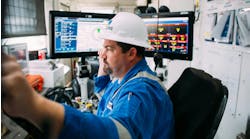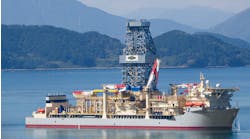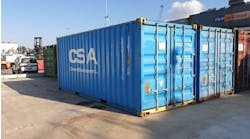(LEFT) The government has decided that the whole of Esso's Odin platform should be brought back to land.Winning the first contract for the removal of offshore facilities on the Norwegian shelf - Elf Norge's North-East Frigg - is an important reference for Kvaerner. Together with its partner Stolt Comex Seaway (SCS), the company also collects kudos for its imaginative disposal plan, which sets an interesting precedent for future abandonments.
Kvaerner is doubly involved in the North-East Frigg contract, as the winning bid was submitted by a joint venture set up for this project by Kvaerner Installasjon and Kvaerner Stolt. The latter is itself a long-term joint venture between Kvaerner and the Stolt Group.
The composition of the winning team is itself an indication of the flexible approach a multi-faceted contractor like Kvaerner, together wit a partner like Stolt, can bring to individual contracts, according to Rolf Olavesen, marketing manager at Kvaerner Installasjon. "We are able to tailor our offer very precisely to the needs of the project," he says.
In the case of North-East Frigg it is SCS which is responsible for the main part of the work, which involves bringing to shore a 130-meter high articulated control column, the 7,000-ton concrete base it stands on, a six-slot subsea template, and flowlines and control cables.
The concrete base was to be dumped in a fjord, but instead the contractors have found a possible new role for it as a floating jetty on a fish farm. The steel articulated column will become a mole at a marina, while the control module it supports will start a new career as a training facility. The template will be melted down for re-use.
According to Elf, Kvaerner Stolt's bid has enabled the overall cost of the abandonment to be reduced by 10% to NKr 185 million. As Olavesen points out, Kvaerner Installasjon stands to benefit if abandoned offshore structures are brought to shore rather than dumped, as this creates more work for it. The company is the Kvaerner group's main vehicle for abandonment projects, for which it can offer the facilities at Kvaerner Concrete Construction's Hanoeytangen yard, which include a deepwater quay. This is one of several alternative sites to which it could bring the Brent Spar. The company is currently on Shell's long-list of some 20 contractors.
What the group lacks, however, is a top-of-the-range heavy-lift vessel, and here Olavesen sees a problem which could obstruct an orderly and economic development of the market. Heavy-lift capability is restricted to a duopoly - Heeremac and Saipem - which could mean expensive bills for using either of their barges for abandonment purposes.
As both Heeremac and Saipem have entered into long-term arrangements with HMV and Aker respectively for bidding abandonment work, other contractors like Kvaerner could find themselves left in the cold. There could also be bottlenecks if several large projects arise at the same time. Some of the platforms represent an immense amount of work. Statoil's Statfjord A, for example, which is likely to be one of the first large platforms to cease production, has a topsides weighing 48,000 tons. One solution could be the development of alternative means such as floating off topsides structures. Kvaerner Installasjon and Kvaerner Rosenberg are now putting their heads together to develop cost-effective concepts minimizing the use of heavy-lift vessels.
The attribution of responsibility and liability must also be clearly understood, Olavesen says. In the case of the North-East Frigg facilities, Kvaerner Stolt takes on ownership in the course of performing its contract. Thus it becomes the owner of the subsea template when it is lifted free of the seabed on the lift-vessel's hook, and owner of the articulated column once it has been brought inshore and the first mooring line attached.
When the column, the control module and the concrete base have been delivered to their future users, ownership also passes to them. So, presumably, does liability in the event of a subsequent incident or accident. Olavesen does not see any problems arising in this respect.
He sees the government's decision to recover the North-East Frigg and Odin structures to land as setting an encouraging trend towards environmentally friendly and politically acceptable solutions. "We believe that, where possible, this is the way to go," he says.
Policy pointers
The destiny of Esso Norge's Odin platform has been decided - the government wants it brought back to shore in its entirety. A NKr 190 million contract has been awarded to a joint venture between Aker and Saipem.
Esso had proposed bringing the topsides back to shore but toppling the jacket to create an artificial reef. The industry and energy ministry says it did not consider this to be a viable option in the case of Odin "due to the uncertainty connected with leaving the installation in place." This did not "rule out the possibility of offshore disposal in the future," it added. However, bearing in mind that the government has ruled that all the North-East Frigg structures should be recovered to shore, over-riding Elf's proposal to dump some of them, it is beginning to look as if the dumping option will only be considered in extreme cases.
The Odin pipelines are to be left in place pending completion of a general study on the decommissioning of oil and gas pipelines.
The estimated cost of the abandonment project is NKr 245 million, of which the government is liable to pay about half. Aker and Saipem plan to remove the platform in September, assuming that parliamentary approval for the plan comes by mid-year. The 7,600-tonne topsides and 6,200-ton jacket will be taken to the Aker Stord yard. Where possible, the various parts will be re-used or recycled, or otherwise scrapped.
Copyright 1996 Offshore. All Rights Reserved.



